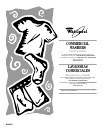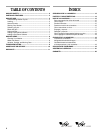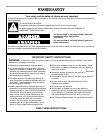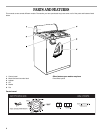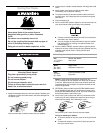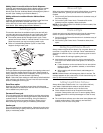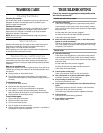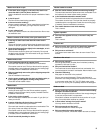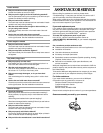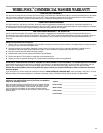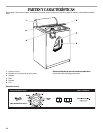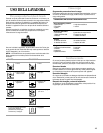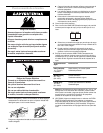
7
Adding bleach to models without a bleach dispenser
If desired, add measured liquid chlorine bleach after the washer
starts agitating. Pour diluted bleach around the agitator, not
directly onto the load. Undiluted bleach will damage any fabric it
touches. (See “Adding Liquid Chlorine Bleach.”)
Adding softener to models without a fabric softener
dispenser
If desired, add measured liquid fabric softener to the final rinse
water. Always dilute fabric softener with ½ to 1 cup
(125 to 250 mL) of warm water. Undiluted fabric softener can
stain fabrics. (See “Adding Liquid Fabric Softener.”)
Selecting a Cycle
This section describes the available wash cycles and will help
you make the best cycle selections for your wash loads. Each
cycle is designed for different types of fabric and soil levels.
■
The washer pauses briefly throughout each cycle. These
pauses are normal. Refer to “Normal Sounds” to learn more
about the sounds you may hear during a wash cycle.
■ Refer to “Understanding Washer Cycles” to learn what
happens during a wash cycle.
Regular cycle
This cycle features high-speed agitation for cleaning cottons and
linens. High spin speeds shorten drying time. Select Normal or
Heavy settings for loads that are moderately or heavily soiled. For
lightly soiled loads, use the shortest Light setting.
Super -
Select the Super setting to wash heavily soiled loads that
need maximum soil removal. Use two times the recommended
amount of detergent for this cycle.
Extra Rinse option
Selecting this option provides a second rinse with the same
water temperature as selected for the first rinse. An Extra Rinse
can be added to any wash cycle.
Permanent Press cycle
This cycle starts with high-speed agitation and then steps down
to low-speed agitation for cleaning permanent press blends and
synthetic fabrics. To minimize wrinkling, this cycle features a
cool-down rinse and a low-speed final spin. Select Light or
Normal settings to clean lightly to moderately soiled loads.
Gentle cycle
This cycle features low-speed agitation, followed by a short spin.
Select Gentle setting to gently clean special-care items that are
lightly or moderately soiled.
Rinse and Spin
When using extra detergent for heavily soiled clothes, or washing
special-care items, you may find an extra rinse and spin is
needed.
1.
Push in the Cycle Control knob and turn it clockwise to any of
the Rinse settings.
2.
Pull out the Cycle Control knob. The washer fills to the
selected load size, agitates, drains, and spins.
NOTE:
An Extra Rinse option is available (on some models). See
“Starting Your Washer.”
Drain and Spin
A drain and spin may help shorten drying times for some heavy
fabrics or special-care items by removing excess water.
1.
Push in the Cycle Control knob and turn it clockwise to any of
the Spin settings.
2.
Pull out the Cycle Control knob. The washer drains, then
spins.
Adding Liquid Chlorine Bleach
Always measure liquid chlorine bleach. Do not guess. Never use
more than 1 cup (250 mL) for a full load. Follow manufacturer’s
directions for safe use. Use a cup with a pouring spout to avoid
spilling.
1.
Let the washer fill and begin agitating the load.
2.
Add bleach to the wash cycle so it can be removed in the
rinse cycle. Pour bleach around the agitator, not directly on
the load.
■
Follow directions on the care labels. Do not use chlorine
bleach on wool, silk, spandex, acetates, or some flame-
retardant fabrics.
■
When soaking with chlorine bleach, add detergent to
soak water.
NOTE:
Undiluted bleach will damage any fabric it touches. The
damage appears as rips, holes, tears, or color loss and may not
show up until several washings later.
Adding Liquid Fabric Softener
Always dilute fabric softener with ½ to 1 cup (125 to 250 mL)
warm water. Undiluted fabric softener can stain fabrics.
■
Add diluted fabric softener only in the final rinse.
■
Fabric softener should not be mixed with other laundry
products. Greasy stains can form. To remove greasy stains,
wet the stain and rub with liquid detergent or a bar of soap.
Rewash.
■
Too much fabric softener can make some items (diapers and
towels) nonabsorbent. If this happens, use less fabric
softener, or do not use it every time.



